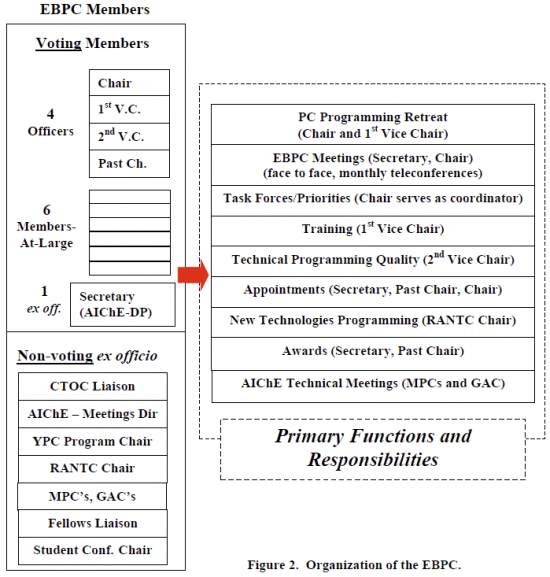5. The Executive Board
5.1 Functions of the EBPC. The Executive Board of the Program Committee (EBPC) has the following broad functions and responsibilities:
- Leadership of the PC.
- Establish policy and procedures for the Institute's technical and professional meetings.
- Organize and conduct meetings of the PC at the AIChE Program-ming Retreat / Spring Meeting and Annual Meeting and as deemed appropriate throughout the year.
- Approve co-sponsorship and co-organization of technical meetings with other societies.
- Maintain channels of communication within the PC and between the PC and AIChE Headquarters staff.
- Planning.
- Oversee and plan the content and format of the Institute's technical and professional meetings.
- Carry out long-range planning for meetings and other programming activities.
- Coordinate and encourage interdisciplinary efforts.
- Develop programming on new technologies, aided by RANTC.
- Quality.
- Monitor and maintain the quality of AIChE’s technical and professional meetings (e.g., based on feedback from participants and the professional community).
- Oversee their technical relevance and impacts.
- Appointments.
- Recommend the Meeting Program Chairs (MPC's) and General Arrangements Chairs (GAC’s) for the Institute’s meetings.
- Appoint new EBPC members.
- Training.
- Train MPC's, GAC’s, new PC members, meeting session chairs, and speakers.
- Maintain appropriate manuals to support this function.
- Awards.
- Select the Institute Lecturer, the George Lappin Program Committee Service Award, the Herb Epstein Award and any other awards to be administered by the PC.
5.2 Membership of the EBPC. The structure and organization of the EBPC are shown in Fig. 2. The EBPC consists of eleven voting members—four officers, six members-at-large, and one ex officio member from AIChE Headquarters—and several non-voting ex officio members that serve important advisory roles.
The officers of the PC (and EBPC) are the Chair, 1st Vice Chair, 2nd Vice Chair, and Past Chair, each to serve for a term of one year. The Chair must be formally approved by CTOC. The 2nd Vice Chair is elected by EBPC and normally progresses through succes-sion in the order: 2nd Vice Chair, 1st Vice Chair, Chair, and Past Chair. Consequently, the 2nd Vice Chair has a four-year commitment to the EBPC. Officers of the PC are normally selected because of their demonstrated leadership within the PC structure and their experience as a Meeting Program Chair. In the event of vacancy, the EBPC will select a suitable replacement.
There are six members-at-large with three-year terms, two appointed each year; these members as well as the officers are assigned duties by the Chair. The terms of the four officers and six at-large members begin January 1 of the appropriate years.
The EBPC may organize itself into various task forces or committees to accomplish its functions.
The final voting member of the EBPC is a staff member of AIChE appointed by the Ex-ecutive Director. This ex officio member, serving as EBPC Secretary without term limita-tions, is normally the AIChE Director of Program Development.
The ex officio non-voting members of the EBPC are: 1) the CTOC Liaison, appointed by the chair of CTOC, 2) the Director of Meetings, 3) the Chair or the Chair’s designee of the Research and New Technology Committee (RANTC), 4) Young Professionals Com-mittee Program Chair 5) Fellows Liaison 6) Student Conference Chair and 7) the Meeting Program Chairs and co-chairs who are currently serving.
5.3 Responsibilities of the members and officers. The members of EBPC support its functions and assist the officers. The functions and responsibilities of the officers are as follows (see also Fig. 2):
- Chair:
- General oversight of the EBPC and the PC.
- Chairs the PC Programming Retreat and EBPC meetings.
- Leads the strategic and tactical planning activity of the EBPC and the PC, including integration and alignment with planning efforts of the programming groups, of CTOC and of the AIChE Board.
- Makes EBPC appointments and coordinates task forces.
- Chairs the Institute Lecture at the Annual Meeting.
- Provides an annual update at the CTOC meeting at the Spring and Annual Meetings.
- 1st Vice Chair:
- Plans and organizes the PC Programming Retreat for the following year (by which time he/she will be Chair).
- Oversees training activities.
- 2nd Vice Chair:
- Oversees technical programming quality initiatives.
- Past Chair:
- Chairs the EBPC Awards Committee.
- Coordinates appointments to EBPC, MPC’s and GAC’s.
- Chair of Group 18: Liaison Functions.
- Secretary:
- Prepares minutes of the EBPC meetings.
- Assembles materials needed for these meetings, including the annual Programming Retreat.
- Coordinates and/or supports all EBPC/PC activities.
- Supports the Chair of EBPC in his/her duties.

5.4 EBPC Meetings. EBPC normally meets on the weekend prior to the start of each Spring Meeting (in conjunction with PC Programming Retreat) and Annual Meeting. The EBPC also meets in monthly teleconference meetings during the year. A quorum consists of a majority, i.e., six, of the voting members.
EBPC meetings are generally open to other participants at the discretion of the Chair.
Selection of officers and members-at-large of the EBPC and selection of MPC's and GAC's requires approval of 2/3 of the voting members of the EBPC. Removal of these people for failure to meet the obligations of their positions also requires a 2/3 vote of the voting members of the EBPC.
Approval of all other business items requires a simple majority of those voting members present at a regular meeting of the EBPC (quorum required) or of a majority of the voting members outside of a regular meeting (e.g., by e-mail).
| <<Previous Page | Next Page>> |
- Log in to post comments
